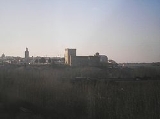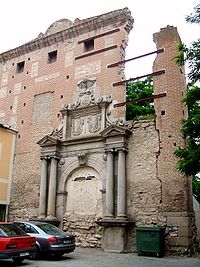
Arévalo
Encyclopedia
Arévalo is a municipality in Spain, it is situated in the province of Ávila and is part of the autonomous community of Castile and León
. The name came from Celtic word
arevalon, meaning "place near the wall."
was raised here as a young girl. The government of Spain has declared this city a Historic-Artistic site due to its many examples of Mudejar art.

In addition to this there are many other brick monuments from different eras. The palace of los Gutierrez de Altamirano, the house of the militia, the palace of Cárdenas, the palace of río Ungria, the palace of real, the palace of Ballesteros Ronquillo, the palace of Sedeño and the palace of general Vicente del Río. There are also diverse convents, the castle in which the museum of cereal resides, plaza del Arrabal plaza Del Real, plaza de San Pedro and plaza de la Villa.
 The highway A-6 unites Madrid with La Coruña and some of the population uses this transit system to commute to the main cities of the northwest peninsula.
The highway A-6 unites Madrid with La Coruña and some of the population uses this transit system to commute to the main cities of the northwest peninsula.
Also the train line Madrid-Hendaya has a stop in this town. From this line, the town is communicated thanks to its numerous regional trains with cities such as Madrid, ávila, Medina del Campo, Valladolid, Burgos, Palencia, Vitoria and Santander.
 In addition, Arévalo has other places of interest like la formidable Avenida Emilio Romero, a sports facility, a new bridge constructed , the plaza of the villa, (in spanish, Plaza de la Villa), the municipal library, the museum of el cereal, the nature center in la Plaza del Real, and the Tuesday market in the fairground.
In addition, Arévalo has other places of interest like la formidable Avenida Emilio Romero, a sports facility, a new bridge constructed , the plaza of the villa, (in spanish, Plaza de la Villa), the municipal library, the museum of el cereal, the nature center in la Plaza del Real, and the Tuesday market in the fairground.
Castile and León
Castile and León is an autonomous community in north-western Spain. It was so constituted in 1983 and it comprises the historical regions of León and Old Castile...
. The name came from Celtic word
Celtic languages
The Celtic languages are descended from Proto-Celtic, or "Common Celtic"; a branch of the greater Indo-European language family...
arevalon, meaning "place near the wall."
Regional importance
The city is the capital of La Moraña. Queen Isabella I of CastileIsabella I of Castile
Isabella I was Queen of Castile and León. She and her husband Ferdinand II of Aragon brought stability to both kingdoms that became the basis for the unification of Spain. Later the two laid the foundations for the political unification of Spain under their grandson, Charles V, Holy Roman Emperor...
was raised here as a young girl. The government of Spain has declared this city a Historic-Artistic site due to its many examples of Mudejar art.
Location and population
It is located at an altitude of 820 meters and is near the junction of the two rivers Adaja and Arevalillo. Its encompassed area is 46.07 km² and its population is 13.122. In medieval times, it was the head of the agricultural sector (Comunidad de Villa y Tierra) of the same name.Monuments

- La Muralla. The city walls, of which only the north part can be appreciated, as the east part is practically destroyed. It is currently being restored. They originally had five doors and formed a triangle with the castle in its superior vertex. The two sides of the triangle are formed by the rivers Arevalillo and Adaja. The base of the triangle was protected by a double wall and a pit.
- The parish church of Santo Domingo de Silos.
- The church of San Juan.
- The church of Santa María whose tower is crossed by the street of the same name.
- The church of San Miguel which possesses a great collection of works of art.
- The church of San Martín or of the Torres Gemelas(twin towers). Formerly a mosque, it conserves a peculiar style.
- The church of El Salvador(the savior) in which the floats for the Easter processions are kept.
In addition to this there are many other brick monuments from different eras. The palace of los Gutierrez de Altamirano, the house of the militia, the palace of Cárdenas, the palace of río Ungria, the palace of real, the palace of Ballesteros Ronquillo, the palace of Sedeño and the palace of general Vicente del Río. There are also diverse convents, the castle in which the museum of cereal resides, plaza del Arrabal plaza Del Real, plaza de San Pedro and plaza de la Villa.
Commuting

Also the train line Madrid-Hendaya has a stop in this town. From this line, the town is communicated thanks to its numerous regional trains with cities such as Madrid, ávila, Medina del Campo, Valladolid, Burgos, Palencia, Vitoria and Santander.
Economy
Farming, cattle ranching, lumber industry, a small but powerful industrial sector and other businesses which are fundamentally based upon the processing of agriculture are the main forms of employment.Education
There are 3 schools, C.P. La Moraña, C.P. Los Arevacos and el Amor de Dios, which operate in this district. Additionally there are 3 centers for secondary education, Los Salesianos, I.E.S Adaja y I.E.S Eulogio Florentino Sanz.Places of interest


